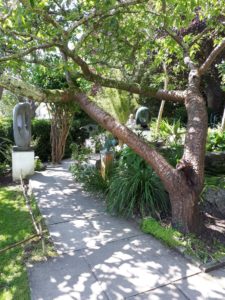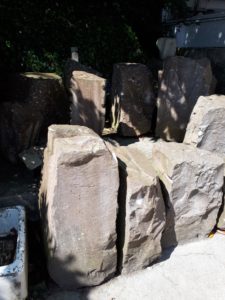22 June 2017
Gems Amongst Jewels
Trewyn Studio Garden, St. Ives
by J.R.Thomas
If you are going to create a garden, Cornwall is probably just about the best place in the British Isles to do it. The climate is wonderfully benign, aided by some sidewash from the gulf stream and the moderating influence of the sea; to say nothing of large infusions of rain water, though mostly delivered in the autumn and winter, with summer sea frets to keep plants moistly happy, if not the tourists. There is rarely frost; careful choosing of the site, and judicious planting of shelter, will protect from the winter gales. Indeed, the Cornish garden owner will soon find that the problem is not getting things to grow, but keeping that growth under some sort of control, if all is not to be submerged in a jungle of lushness.

Which all goes to suggest that Dame Barbara Hepworth and those devotees to her memory who now tend her garden need to be aces with the secateurs and devotees of the lopping knife. And with especially good reason in the garden which she made at Trewyn Studio, her home and workplace in St Ives on the north coast of Cornwall. The Sculpture Garden is well hidden in the crowded townscape of St Ives and surprises visitors to the studio displays as they walk out of the back door into this sheltered but north east facing space. It feels surprisingly large, yet initial exploration soon reveals to the musing visitor that the garden is in truth of modest size but carefully planned and generously planted. That planting gives impressions of enclosure but also releases views from one glade to another and outwards across the town roofs to the Atlantic waves endlessly shaping the north Cornish coast. The contrast with the rolling acres of woodland and paddocks around Henry Moore’s studio in Hertfordshire is startling, and, one suspects, most have caused those two fellow Yorkshirepersons and great friends some amusement.
Miss Hepworth lived in the house and worked in the adjacent studio from 1949 until her death in 1975, and the garden was partly her workplace. It contains her workshops, the wonderfully old fashioned greenhouse which she used both for plants and drying her casts, and a huge outdoor turntable which was used for carving. The garden contains a number of finished works, in particular three large stone sculptures, and eighteen bronzes which she retained as the artist’s copies from commissioned works. Most evocative perhaps is the store of stone pieces waiting for the sculptor’s chisel that was wielded no more after 1975.
These are positioned amongst a range of plants set mostly as sheltering enclosures; but all dominated by a huge central cherry tree, which has flourished on this sheltered hillside, its long declining branches forming a lichened frame off which parts of the garden seem to hang. The garden, like so many Cornish gardens, is probably at its best in spring, but Dame Barbara gardened for year-long interest and to form those bowers for her sculpture. Castor oil plants and bamboo groves help perform this function to great effect.

One of the problems in a small garden which is intensely used and open most of the year is renewing and refreshing the planting. Some of the shrubs and trees have really grown too big to properly fulfil their function in the design, but to take them out would create gaps in what is after all a modest space. No doubt most of the visitors who walk round are looking mostly at the sculptures, which are indeed magnificent and compelling, and are probably almost unaware of their carefully crafted setting. But even temporary holes in the planting would strike a discordant note, and one can only have sympathy for the gardener who must manage the renewal in so delicate a manner. The ageing cherry tree in particular must be a subject of troubled dreams.
Smaller gardens with heavy footfall have somehow to manage the falling of those feet. The lower garden has some moderately intrusive paving but in the upper areas the conundrum is managed very well, and it must be very much as Miss Hepworth knew it. It rarely gets intrusively busy and even a short visit will form a calming and restful interlude created by the interplay of foliage, plants, and a quiet break from the packed streets of St Ives on the other side of the wall.
The Barbara Hepworth Museum and Sculpture Garden is run by the Tate St Ives (which will itself fully reopen after enlargement in October this year). The Hepworth is open daily from 10am to 5pm (4pm in winter).
If you enjoyed this article please share it using the buttons above.
Please click here if you would like a weekly email on publication of the ShawSheet

